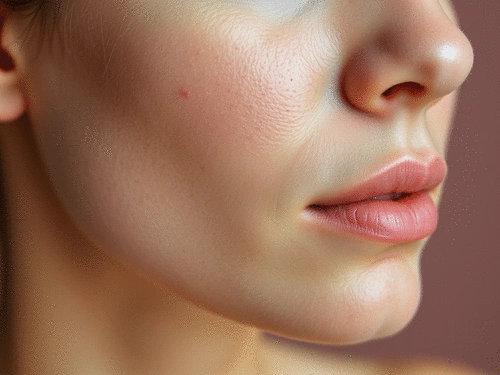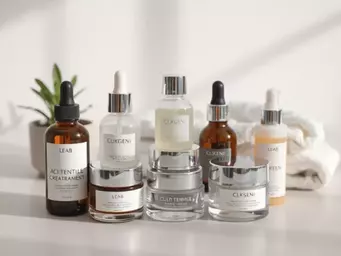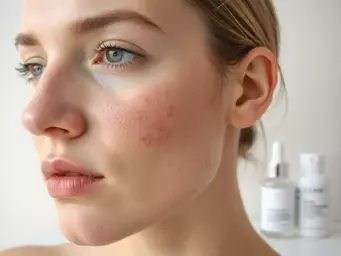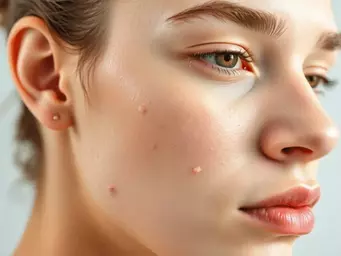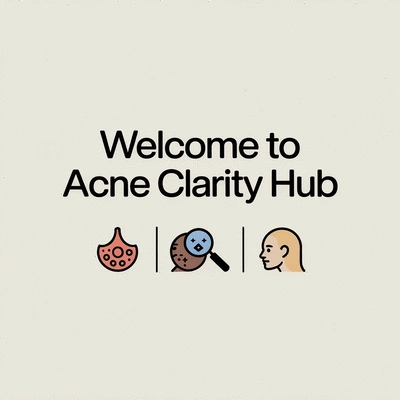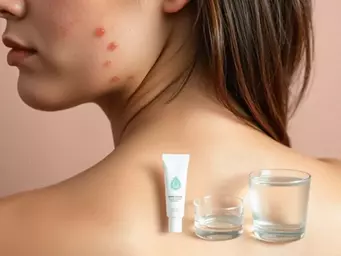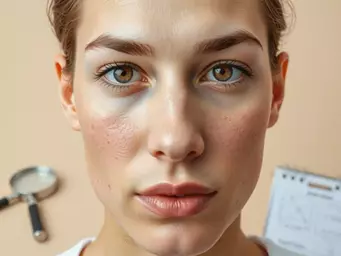What if understanding hormonal acne could be the key to unlocking clearer skin? With insights into the biological mechanisms at play, you can take control of your skincare journey like never before!
What You Will Learn
- Hormonal fluctuations, particularly androgens, significantly contribute to acne by increasing sebum production.
- Understanding the roles of estrogen and progesterone is crucial for managing hormonal acne effectively throughout various life stages.
- Recognizing patterns of hormonal acne during puberty, menstrual cycles, pregnancy, and menopause can aid in anticipating breakouts.
- Identifying hormonal imbalances through testing can help tailor effective treatment plans for acne.
- Lifestyle changes, including diet, hydration, and stress management, play a vital role in preventing hormonal acne flare-ups.
- Consulting healthcare providers about your skincare regimen and hormonal symptoms can lead to more effective treatment options.
Understanding How Hormones Impact Acne Across Life Stages and Genders
Hormones play a pivotal role in acne development, with different hormones influencing sebum production and acne patterns throughout various life stages and between genders. This visual highlights key hormonal influences and distinctions.
Key Hormonal Influences on Sebum Production
Androgens (e.g., Testosterone)
Increase size and activity of sebaceous glands, leading to **excess sebum production** and clogged pores.
Estrogen & Progesterone
**Estrogen** can reduce sebum. **Progesterone** can sometimes exacerbate acne. A crucial balancing act.
Hormonal Fluctuations Across Life Stages
- Puberty: Surge in androgens, increased oil.
- Menstrual Cycle: Drop in estrogen, rise in progesterone pre-period.
- Pregnancy & Menopause: Significant hormonal shifts.
- PCOS: Hormonal imbalance, increased androgens.
Acne Patterns: Gender Differences
Men
- Larger, deeper cystic acne.
- More likely to have body acne.
Women
- Hormonal acne often on lower face.
- Acne concentrated around the jawline.
Holistic Management: Beyond Hormones
Managing hormonal acne effectively involves understanding biological mechanisms, life stage influences, and gender patterns, alongside lifestyle changes, stress management, and psychological support.
Understanding Hormonal Influence on Acne Development
When it comes to understanding hormonal acne, it’s essential to delve into the biological mechanisms at play. Hormones can be powerful influencers on our skin, particularly during various life stages. In this section, we’ll explore how hormonal fluctuations can lead to breakouts, why they occur, and how to identify hormonal acne compared to other types.
How Hormones Trigger Breakouts: The Biological Mechanism
Let’s start by examining how hormones actually affect our skin! Hormones, especially androgens, play a significant role in stimulating the sebaceous glands, leading to increased sebum production. This excess oil can clog pores and create the perfect environment for acne to thrive. For a deeper understanding of hormonal acne, including its impact across different life stages, you can refer to this comprehensive article on hormonal acne: skin changes you must know.
The Role of Androgens in Sebum Production
Androgens, such as testosterone, are often the culprits behind hormonal acne. They increase the size and activity of sebaceous glands, resulting in more oil on the skin. With more oil comes a higher likelihood of clogged pores and acne formation.
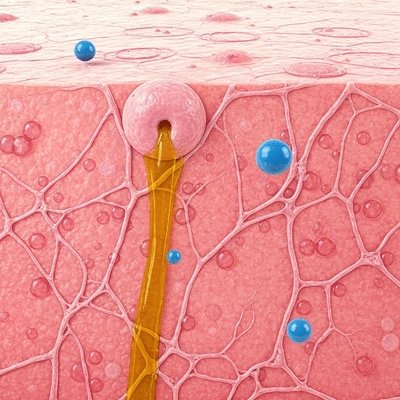
Estrogen and Progesterone: Balancing Act in Acne
On the flip side, hormones like estrogen and progesterone can have a balancing effect. Estrogen can help reduce sebum production, while progesterone can sometimes exacerbate acne. This balancing act is why understanding your hormonal cycles is crucial for managing acne effectively.
The Impact of Hormonal Fluctuations Across Life Stages
Throughout our lives, hormonal fluctuations can trigger acne at various stages. Recognizing these patterns can help you anticipate and manage breakouts better.
Puberty: The Onset of Hormonal Acne
During puberty, the surge in androgens leads to increased oil production, which often results in teenage acne. It’s a common phase, but understanding it can ease the anxiety of those experiencing their first breakouts.
Menstrual Cycle: Monthly Breakouts Explained
Many women notice that their acne flares up before their period. This is linked to the drop in estrogen and the rise in progesterone, creating a perfect storm for acne. Keeping track of your cycle can be a helpful tool in managing these breakouts.
Pregnancy and Menopause: Hormonal Changes and Acne
Both pregnancy and menopause bring significant hormonal changes that can impact skin health. During pregnancy, some may experience clearer skin due to heightened estrogen, while others may find they have more acne due to hormonal fluctuations. Menopause can also lead to a decrease in estrogen, resulting in dryness and potential breakouts. For more insights into how adult female hormones influence acne, explore this article from Skin Therapy Letter.

Polycystic Ovary Syndrome (PCOS): A Common Trigger
For many women, PCOS is a significant factor in hormonal acne. This condition can cause a hormonal imbalance, leading to increased androgens and subsequent acne. It’s essential to consult with a healthcare provider for proper diagnosis and treatment options.
Understanding Hormonal Imbalance and Its Role in Acne
Recognizing hormonal imbalances is crucial for effective acne treatment. Testing for hormone levels can help identify underlying issues that may be contributing to your skin concerns, allowing for targeted treatment plans.
Distinguishing Hormonal Acne from Other Types
Not all acne is created equal! Understanding the differences can greatly improve your treatment approach.
Understanding Fungal Acne vs. Hormonal Acne
Fungal acne, or Malassezia folliculitis, can often be mistaken for hormonal acne. However, fungal acne typically appears as small, itchy bumps and is treated differently. Knowing your acne type can lead to more effective solutions!
Key Differences in Acne Patterns Between Genders
- Men typically experience larger, deeper cystic acne due to higher androgen levels.
- Women often experience hormonal acne in the lower face, especially during hormonal fluctuations.
- Men are more likely to have body acne, while women often have acne concentrated around the jawline.
By understanding these distinctions, you can better tailor your skincare regimen to your specific needs. At Acne Clarity Hub, we believe that knowledge is power in the fight against acne!
Interactive Poll: Your Experience with Hormonal Acne
Have you ever experienced hormonal acne? Understanding how it affects you can help in managing it better. Please share your thoughts below:
Frequently Asked Questions About Hormonal Acne
- What is the primary cause of hormonal acne?
- Hormonal acne is primarily caused by fluctuations in hormones, particularly androgens, which stimulate increased sebum (oil) production in the skin. This excess oil can clog pores and lead to breakouts.
- How do estrogen and progesterone influence acne?
- Estrogen generally helps to reduce sebum production, potentially improving acne. Progesterone, however, can sometimes exacerbate acne. The balance between these hormones is crucial, and shifts can influence acne development, especially during the menstrual cycle, pregnancy, and menopause.
- What are common life stages when hormonal acne is prevalent?
- Hormonal acne is often prevalent during puberty due to a surge in androgens. Many women experience flare-ups before their menstrual period, and significant hormonal shifts during pregnancy and menopause can also trigger acne. Conditions like Polycystic Ovary Syndrome (PCOS) are also common triggers.
- How can I differentiate hormonal acne from fungal acne?
- Hormonal acne often appears as deeper, cystic lesions, particularly around the jawline and lower face. Fungal acne (Malassezia folliculitis) typically presents as small, itchy, uniform bumps and requires different treatment methods than bacterial or hormonal acne.
- What holistic approaches can help manage hormonal acne?
- Holistic management includes addressing the psychological impact of acne, integrating lifestyle changes such as a balanced diet and proper hydration, and practicing stress management techniques like meditation or yoga. Consulting with healthcare providers for personalized advice and considering hormonal tests are also key steps.
Summarizing the Role of Hormones in Acne Management
Understanding the intricate relationship between hormones and acne is crucial for effective management. At Acne Clarity Hub, I believe in taking a holistic approach that not only addresses the physical symptoms of hormonal acne but also considers the emotional and psychological impacts it can have on individuals. This comprehensive view is essential for fostering a healthy skincare journey.
Hormones can significantly influence your skin, and recognizing how they interact with other factors can help you devise a more effective treatment plan. Here’s a closer look at how holistic approaches can empower you in managing hormonal acne.
Holistic Approaches to Managing Hormonal Acne
When tackling hormonal acne, it’s beneficial to adopt a holistic mindset. This means integrating various strategies to create a customized approach. Here are some essential elements to consider:
- Addressing Psychological Impact: Acne can affect self-esteem and mental health. It's vital to recognize these feelings and seek supportive resources.
- Integrating Lifestyle Changes: Simple adjustments in daily routines can result in significant improvements.
- Implementing Stress Management Techniques: Stress is a known trigger for acne flares, making stress reduction strategies like meditation or yoga particularly beneficial.
By focusing on these key areas, you’re not just treating the symptoms but also nurturing your overall well-being, which is essential for long-term success.
The Importance of Addressing Psychological Impact
As a dermatologist, I often see how the psychological toll of acne can be just as challenging as the physical symptoms. It's important to acknowledge your feelings and consider seeking therapy or support groups, which can provide a safe space for expressing emotions about your skin journey. Remember, you’re not alone in this!
Integrating Lifestyle Changes for Better Management
Making lifestyle changes can have a profound effect on hormonal acne. Here are a few tips to integrate into your daily life:
- Prioritize a balanced diet rich in fruits, vegetables, and whole grains.
- Stay hydrated by drinking plenty of water.
- Establish a consistent skincare routine tailored to your skin type.
- Ensure you get enough sleep to support skin regeneration.
These adjustments can help create a more favorable environment for your skin, promoting its health and clarity.
Stress Management Techniques for Acne Prevention
Incorporating stress management techniques can play a vital role in preventing hormonal acne flare-ups. Methods such as mindfulness meditation, deep breathing exercises, and regular physical activity can significantly reduce stress levels. These practices not only support your mental health but also positively impact your skin's condition.
Your Next Steps for Managing Hormonal Acne
Now that you have a deeper understanding of hormonal acne management, it’s time to take action! Here are some practical steps you can follow as you navigate your skincare journey.
Consulting with Healthcare Providers: What to Discuss
When planning to consult with your healthcare provider, come prepared with questions. Discuss:
- Your current skincare regimen and any products you’re using.
- Any previous treatments and their effectiveness.
- Your menstrual cycle and any related symptoms.
- Your diet, lifestyle, and any stressors in your life.
Being open about your experiences will help your provider offer the best recommendations tailored to your needs.
Maintaining a Long-Term Acne Management Strategy
Setting up a long-term strategy for managing hormonal acne is essential. Stay committed to your skincare routine and regularly evaluate its effectiveness. Don't hesitate to adjust your approach if needed, and keep an eye on how changes in your lifestyle influence your skin. Consistency is key!
Understanding Hormonal Tests and Their Relevance to Acne
Finally, understanding hormonal tests and how they relate to acne can provide valuable insights. Talk to your healthcare provider about testing options for hormonal imbalances, such as testosterone or androgen levels. These tests can help pinpoint specific issues, allowing for a more targeted treatment approach.
At Acne Clarity Hub, I’m here to support you through every step of your journey. Remember, clear skin is possible, and knowledge is your greatest ally in achieving it!
Recap of Key Points
Here is a quick recap of the important points discussed in the article:
- Understand Hormonal Triggers: Androgens increase sebum production, leading to blocked pores and acne.
- Recognize Life Stage Influences: Hormonal fluctuations during puberty, menstrual cycles, pregnancy, and menopause can trigger acne.
- Identify Acne Types: Differentiate between hormonal acne and fungal acne for effective treatment.
- Adopt a Holistic Approach: Integrate psychological support, lifestyle changes, and stress management techniques to manage acne.
- Consult Healthcare Providers: Be prepared with questions regarding your skincare regimen and hormonal health during consultations.

